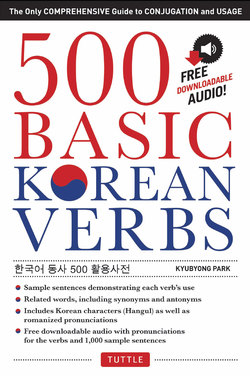Читать книгу 500 Basic Korean Verbs - Kyubyong Park - Страница 7
На сайте Литреса книга снята с продажи.
ОглавлениеPREFACE
Mastering vocabulary is an essential part of learning a foreign language. And what is the most difficult Korean vocabulary to learn? It’s the verbs. Korean verbs aren’t easy for foreign learners, not because there are so many of them but because the particular usage and various conjugation forms of each verb are so specialized.
Let me give you an example. The word 결혼하다 means “to marry.” So try to say this: Will you marry me? The correct Korean is “나랑 결혼해 줄래?” Note that 결혼하다 is combined with the particle - 랑 (or - 과 / - 와), which means “with,” instead of the usual - 를, which marks an “object.” So you should not say “나를 결혼해 줄래?” as it sounds funny and unnatural.
The problem, as this shows, is that English and Korean are totally different languages, so there are many subtle nuances in usage that are not necessarily intuitive for English speakers. In addition, you might have noticed that 결혼하다 became 결혼해 in our example sentence above. As in English, Korean verbs are also conjugated according to their tense, the type of the sentence, and the level of formality. This can become quite complicated and confusing for Korean learners. In the example sentence, 결혼해 is the adverbial conjugation of 결혼하다. But besides this, there are many other conjugation forms.
This book was designed to help learners master basic Korean verbs easily and comprehensively. The 500 most important Korean verbs have been identified and presented in alphabetical order. For each vocabulary item, you can see its pronunciation, romanization, meaning, and the “model verb” that it follows the same conjugation rules as. And then there is also the verb’s table of conjugation, some familiar related words, common sentence patterns, and some sample sentences. I dare say that this is all the essential and practical information you’ll need in order to master each verb. So I hope you will treat this book like a dictionary as well as a guide to studying Korean verbs.
I want to say thanks to Prof. Lee Sang-oak (Seoul National University), who reviewed my manuscript, and to John, who proofread the English part.
Kyubyong Park
